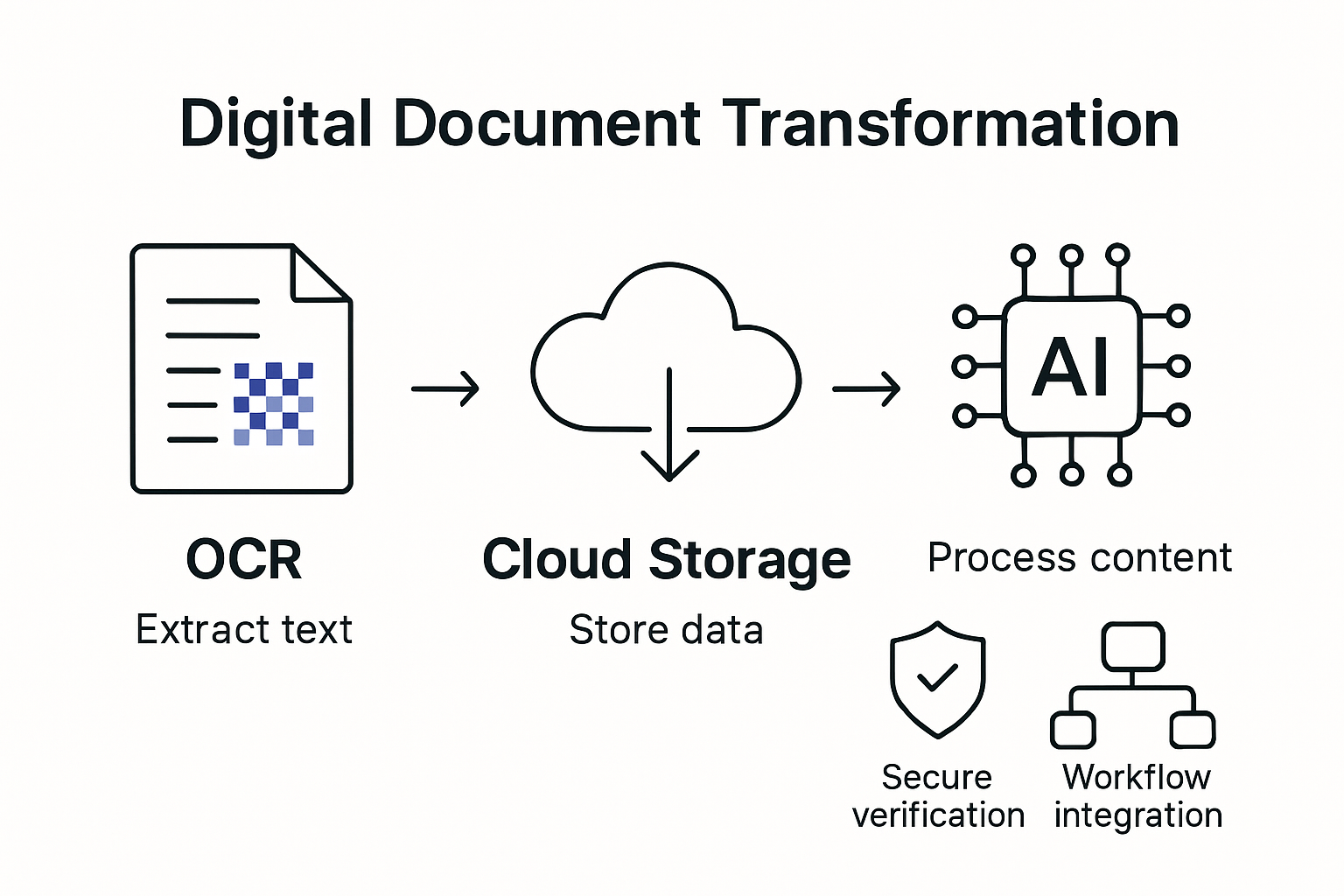Digital document transformation is changing how businesses handle information every day. Nearly 70 percent of organizations say digital document initiatives directly improve their operational efficiency. That sounds like just another tech upgrade, but it is much more than converting paper to pixels. The real impact comes when documents become intelligent assets instead of digital clutter.
Table of Contents
- What Is Digital Document Transformation?
- Why Digital Document Transformation Matters To Businesses
- How Digital Document Transformation Works: Key Concepts
- The Role Of Technology In Digital Document Transformation
- Real-World Applications Of Digital Document Transformation
Quick Summary
| Takeaway | Explanation |
|---|---|
| Digital transformation redefines document management | Organizations must shift from simple digitization to a holistic transformation of workflows and processes. |
| Automation boosts operational efficiency | Implementing automated document processing reduces manual errors and speeds up workflows, leading to significant cost savings. |
| Real-time data access enhances decision-making | Intelligent document transformation allows quicker access to information, enabling faster and more informed decisions across the organization. |
| Compliance becomes streamlined | Automated tracking and management of documents improve regulatory compliance and simplify audit processes. |
| Interconnected data resources empower collaboration | Transforming static documents into dynamic resources fosters better teamwork and communication within departments and with stakeholders. |
What is Digital Document Transformation?
Digital document transformation represents a strategic approach where organizations fundamentally reimagine how they capture, manage, process, and leverage digital documents across their entire operational ecosystem. Unlike simple digitization which merely converts physical documents to digital formats, digital document transformation involves comprehensive technological and procedural changes that unlock significant business value.
Below is a table summarizing the key differences between simple digitization and digital document transformation to clarify their unique business impacts:
| Aspect | Simple Digitization | Digital Document Transformation |
|---|---|---|
| Purpose | Converts paper to digital format | Reimagines workflows and processes |
| Technological Approach | Basic scanning and storage | Integrates AI, automation, and analytics |
| Business Value | Access and store documents digitally | Makes documents intelligent assets |
| Workflow Impact | Minimal change to processes | Comprehensive workflow integration |
| Decision-Making | Limited improvement | Enables fast, data-driven decisions |
| Compliance Tracking | Manual and basic | Streamlined and automated |
Core Conceptual Framework
At its essence, digital document transformation goes beyond technical conversion. It encompasses a holistic reimagining of document workflows that integrates advanced technologies like artificial intelligence, machine learning, and automated processing systems. By transforming documents from static records into dynamic, intelligent assets, businesses can extract deeper insights, improve operational efficiency, and create more responsive organizational structures.
learn more about advanced document workflows can help organizations understand how these transformative processes work in real-world scenarios.
Strategic Business Implications
Businesses implementing digital document transformation typically experience multiple strategic advantages:
The following table summarizes the major strategic business benefits of digital document transformation, as described in the article:
| Benefit | Description |
|---|---|
| Enhanced Operational Efficiency | Automated processing reduces errors and speeds up workflows |
| Cost Reduction | Less paper storage and manual work lowers operational costs |
| Improved Regulatory Compliance | Easier document tracking and audit trail management |
| Accelerated Decision Making | Faster access to information for quicker decisions |
| Streamlined Collaboration | Better information sharing within and across departments |
- Enhanced operational efficiency through automated document processing
- Reduced manual data entry and associated human error risks
- Improved regulatory compliance and document tracking capabilities
- Accelerated decision making through faster information retrieval
According to research from UNDP, digital transformation involves rethinking processes to leverage technological potential, creating new ways of delivering services and engaging with stakeholders. This definition perfectly encapsulates how document transformation transcends mere technological implementation to become a fundamental organizational strategy.
Why Digital Document Transformation Matters to Businesses
Digital document transformation represents more than a technological upgrade. It serves as a critical strategic initiative that fundamentally reshapes how businesses operate, compete, and deliver value in an increasingly digital marketplace. By transforming document management from a passive administrative function to an active strategic asset, organizations can unlock unprecedented operational efficiencies and competitive advantages.
Operational Efficiency and Cost Reduction
Businesses implementing digital document transformation experience significant operational improvements. Automated document processing eliminates manual data entry, reduces human error, and accelerates workflow cycles. explore advanced PDF automation techniques to understand how technological solutions can streamline complex document management processes.
Key operational benefits include:

- Dramatic reduction in paper storage and processing costs
- Enhanced document retrieval speed and accuracy
- Simplified compliance and audit trail management
- Reduced administrative overhead
Strategic Competitive Advantages
Digital document transformation enables businesses to become more agile and responsive. By converting static documents into intelligent, interconnected data resources, organizations can make faster, more informed decisions. This transformation supports advanced analytics, enables real-time collaboration, and creates more transparent communication channels across departments and with external stakeholders.
According to research from SCORE, digital transformation improves workforce efficiency by automating mundane tasks, enhances customer experience through an agile culture, and increases profitability by lowering operational costs and improving cash flow management. These strategic advantages demonstrate why digital document transformation is no longer optional but a critical business imperative in the modern digital economy.
How Digital Document Transformation Works: Key Concepts
Digital document transformation operates through a sophisticated blend of technological processes, advanced software systems, and strategic methodologies designed to convert traditional document management into an intelligent, data-driven ecosystem. By integrating multiple technological components, organizations can transform static documents into dynamic, actionable business assets.
Technological Architecture
The foundational architecture of digital document transformation involves several interconnected technological layers. Optical Character Recognition (OCR) technology plays a critical role by converting scanned documents and images into machine-readable text. explore advanced PDF conversion strategies to understand how document conversion technologies enable comprehensive digital transformation.
Key technological components include:

- Advanced scanning and digitization technologies
- Machine learning algorithms for document classification
- Intelligent metadata extraction systems
- Secure cloud storage and retrieval platforms
Workflow Automation and Integration
Digital document transformation transcends mere digitization by creating intelligent, interconnected workflows. Automated systems can now extract relevant information, route documents through predefined organizational channels, and trigger specific actions based on document content. This approach eliminates manual processing bottlenecks and enables real-time document management across complex business environments.
According to research from the National Institutes of Health, successful digital transformation requires meticulous attention to technical interoperability, workflow automation, and rigorous compliance with security and privacy standards. The research emphasizes that effective digital document transformation is not just about technology implementation but about creating comprehensive, integrated systems that enhance organizational efficiency and reduce operational risks.
The Role of Technology in Digital Document Transformation
Technology serves as the critical backbone of digital document transformation, enabling organizations to reimagine document management through sophisticated digital tools and intelligent systems. By leveraging cutting-edge technological solutions, businesses can transform traditional document handling from a static, paper-based process into a dynamic, data-driven strategic asset.
Advanced Technological Platforms
Modern digital document transformation relies on a complex ecosystem of interconnected technological platforms. These systems integrate multiple advanced technologies to create intelligent document management solutions. discover next-generation PDF management strategies to understand the technological innovations driving document transformation.
Key technological platforms include:
- Cloud-based document management systems
- Artificial intelligence and machine learning algorithms
- Advanced data extraction and processing tools
- Secure blockchain-enabled document verification technologies
Intelligent Document Processing
Technology transforms documents from passive records into active, intelligent resources. Machine learning algorithms can now automatically classify documents, extract relevant information, recognize patterns, and generate actionable insights. Natural language processing enables systems to understand context, sentiment, and nuanced information within documents, dramatically expanding their utility beyond traditional storage and retrieval.
According to research from the Inter-American Development Bank, successful digital transformation requires a comprehensive approach that considers governance, technological infrastructure, legal frameworks, and strategic talent management. The research emphasizes that technology is not just a tool but a fundamental enabler of organizational transformation, requiring holistic integration across multiple strategic domains.
Real-World Applications of Digital Document Transformation
Digital document transformation transcends theoretical concepts, delivering tangible benefits across diverse industries by revolutionizing how organizations capture, manage, process, and leverage critical information. By implementing advanced digital document strategies, businesses can dramatically improve operational efficiency, compliance, and strategic decision making.
Healthcare and Medical Records Management
In healthcare, digital document transformation enables secure, comprehensive patient record management. Electronic health records streamline patient care, enhance communication between healthcare providers, and ensure critical medical information is instantly accessible. explore enterprise document management solutions to understand how technology can transform complex document workflows.
Key applications in healthcare include:
- Secure patient record digitization and management
- Automated insurance claims processing
- Compliance tracking and regulatory reporting
- Seamless inter-departmental information sharing
Financial Services and Compliance
Financial institutions leverage digital document transformation to manage complex regulatory requirements, reduce fraud risks, and improve customer service. Advanced document processing technologies enable banks and insurance companies to automate loan applications, verify customer identities, and generate comprehensive audit trails with unprecedented speed and accuracy.
According to research from Coursera, digital transformation enables organizations to create user-centric services that enhance efficiency and transparency. By implementing intelligent document management systems, businesses can not only streamline internal processes but also provide more responsive and personalized experiences for their customers.
Bring Digital Document Transformation to Life with Mapsoft
If your business is struggling with outdated document workflows or you are concerned about human error and sluggish compliance processes, you are not alone. As explored in the article, organizations today need more than simple digitization. They need intelligent solutions for automated PDF handling, secure document processing, and advanced workflow integration that actually reduce costs and transform productivity. Mapsoft specializes in giving you this exact strategic advantage, letting you move from reactive document handling to proactive business intelligence using industry-leading Adobe technologies.

Why settle for paper-based bottlenecks or complex manual systems? Act now to step into truly dynamic PDF and document processing with Mapsoft PDF Hub and our workflow automation tools. Experience seamless PDF conversions, robust security, and powerful automation features that turn your digital documents into real assets for your enterprise. Visit Mapsoft.com today to find solutions built to maximize your investment in Adobe tools and unlock the full value of digital transformation.
Frequently Asked Questions
What is digital document transformation?
Digital document transformation is the process of reimagining how organizations capture, manage, and process digital documents using advanced technologies like AI and automation. It goes beyond simple digitization by enhancing document workflows and integrating intelligent systems.
Why is digital document transformation important for businesses?
Digital document transformation is crucial because it reshapes how businesses operate, leading to greater operational efficiency, reduced costs, improved compliance, and enhanced decision-making capabilities. It transforms document management from a passive function to a strategic asset.
How do advanced technologies contribute to digital document transformation?
Advanced technologies such as machine learning, optical character recognition (OCR), and cloud-based systems facilitate the transformation of static documents into dynamic, intelligent resources. These technologies automate processes, enhance data extraction, and improve accessibility and security.
What are some real-world applications of digital document transformation?
Digital document transformation is applied in various industries, including healthcare for secure patient record management and financial services for compliance and fraud reduction. It enables organizations to streamline workflows and provide better service by automating routine tasks.



